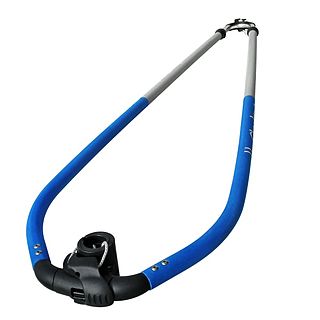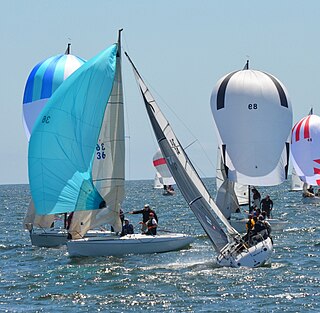
Sailing employs the wind—acting on sails, wingsails or kites—to propel a craft on the surface of the water, on ice (iceboat) or on land over a chosen course, which is often part of a larger plan of navigation.

Spins are an element in figure skating in which the skater rotates, centered on a single point on the ice, while holding one or more body positions. They are performed by all disciplines of the sport, single skating, pair skating, and ice dance, and are a required element in most figure skating competitions. As The New York Times says, "While jumps look like sport, spins look more like art. While jumps provide the suspense, spins provide the scenery, but there is so much more to the scenery than most viewers have time or means to grasp". According to world champion and figure skating commentator Scott Hamilton, spins are often used "as breathing points or transitions to bigger things"

The kickflip is a skateboarding trick, in which the rider flips their skateboard 360° along the axis that extends from the nose to the tail of the deck. When the rider is regular footed the board spins counter-clockwise if viewed from the side.

Kiteboarding or kitesurfing is a sport that involves using wind power with a large power kite to pull a rider across a water, land, or snow surface. It combines the aspects of paragliding, surfing, windsurfing, skateboarding, snowboarding, and wakeboarding. Kiteboarding is among the less expensive and more convenient sailing sports.

Windsurfing is a wind propelled water sport that is a combination of sailing and surfing. It is also referred to as "sailboarding" and "boardsailing", and emerged in the late 1960s from the aerospace and surf culture of California. Windsurfing gained a popular following across Europe and North America by the late 1970s and had achieved significant global popularity by the 1980s. Windsurfing became an Olympic sport in 1984.

A jibe (US) or gybe (Britain) is a sailing maneuver whereby a sailing vessel reaching downwind turns its stern through the wind, which then exerts its force from the opposite side of the vessel. Because the mainsail boom can swing across the cockpit quickly, jibes are potentially dangerous to person and rigging compared to tacking. Therefore accidental jibes are to be avoided while the proper technique must be applied so as to control the maneuver. For square-rigged ships, this maneuver is called wearing ship.

A spinnaker is a sail designed specifically for sailing off the wind on courses between a reach to downwind. Spinnakers are constructed of lightweight fabric, usually nylon, and are often brightly colored. They may be designed to perform best as either a reaching or a running spinnaker, by the shaping of the panels and seams. They are attached at only three points and said to be flown.

Kneeboarding is an aquatic sport where the participant is towed on a buoyant, convex, and hydrodynamically shaped board at a planing speed, most often behind a motorboat. Kneeboarding on a surf style board with fin(s) is also done in waves at the beach. In the usual configuration of a tow-sport kneeboard, riders kneel on their heels on the board, and secure themselves to the deck with an adjustable Velcro strap over their thighs. Most water ski kneeboards do not have fins to allow for easier surface spins. As in wakeboarding or water skiing, the rider hangs onto a tow-rope. The advantages of kneeboarding versus other tow-sports seems to be an easier learning curve and a sense of being closer to the water when falls occur.
Tacking is a sailing maneuver by which a sailing vessel, whose desired course is into the wind, turns its bow toward and through the wind so that the direction from which the wind blows changes from one side of the boat to the other, allowing progress in the desired direction. The opposite maneuver to tacking is called 'jibe', or 'wearing' on square-rigged ships, that is, turning the stern through the wind. No sailing vessel can move directly upwind, though that may be the desired direction, making this an essential maneuver of a sailing ship. A series of tacking moves, in a zig-zag fashion, is called beating, and allows sailing in the desired direction.

The ollie is a skateboarding trick where the rider and board leap into the air without the use of the rider's hands. It is the combination of stomping, also known as popping, the tail of the skateboard off the ground to get the board mostly vertical, jumping, and sliding the front foot forward to level out the skateboard at the peak of the jump.
Rounding-up is a phenomenon that occurs in sailing when the helmsman is no longer able to control the direction of the boat and it heads up into the wind, causing the boat to slow down, stall out, or tack. This occurs when the wind overpowers the ability of the rudder to maintain a straight course.
A freestyle skateboarding trick is a trick performed with a skateboard while freestyle skateboarding. Some of these tricks are done in a stationary position, unlike many other skateboarding tricks. The keys to a good freestyle contest run are variety, difficulty, fluidity, and creativity. This is an incomplete list, which includes most notable tricks.
A flip trick is a type of skateboarding trick in which the skateboard rotates around its vertical axis, or its vertical axis and its horizontal axis simultaneously. The first flip trick, called a kickflip but originally known as a "magic flip", was invented by professional skateboarder Rodney Mullen.

A boom, in the context of windsurfing, is a piece of equipment that attaches to the mast, providing structural support for the sail. It completely encircles the sail, and is designed to be gripped, allowing the sailor to control the sail for normal sailing, and also for almost any type of maneuver. Early pre RAF/Cambered booms were tied on to the mast using rope, but newer booms use a clamp mechanism for attachment.
The Misty Flip is an off axis backside 540 rotation performed in freestyle sports such as freeskiing, snowboarding, skateboarding, inline skating or trampolining. The Misty Flip was first done by Jason King out of the Sugarbush half pipe circa 1991. The trick was later named by professional snowboarder Ali Goulet, an original member of the Vermont Snowboard Posse that included Jeff Brushie, Chris Swierz, and Josh Brownley. Unlike in acrobatic disciplines where athletes remain in the same plane in space during the trick, the backside 540 rotation and off axis spin are combined. Not unlike a McTwist but off a straight jump rather than a transition. Misty Flips can be performed in many variations with bigger spins, grabs and even double Misty.
The following is a glossary of figure skating terms, sorted alphabetically.

A caster board, vigorboard or waveboard is a two-wheeled, human-powered land vehicle. Other names are J-board and RipStik, both of which are derived from commercial brands.
Weather helm is the tendency of sailing vessels to turn towards the source of wind, creating an unbalanced helm that requires pulling the tiller to windward in order to counteract the effect.
British Ice Skating is the national governing body of ice skating within the United Kingdom. Formed in 1879, it is responsible for overseeing all disciplines of ice skating: figure skating ; synchronised skating; and speed skating.

Forces on sails result from movement of air that interacts with sails and gives them motive power for sailing craft, including sailing ships, sailboats, windsurfers, ice boats, and sail-powered land vehicles. Similar principles in a rotating frame of reference apply to windmill sails and wind turbine blades, which are also wind-driven. They are differentiated from forces on wings, and propeller blades, the actions of which are not adjusted to the wind. Kites also power certain sailing craft, but do not employ a mast to support the airfoil and are beyond the scope of this article.












